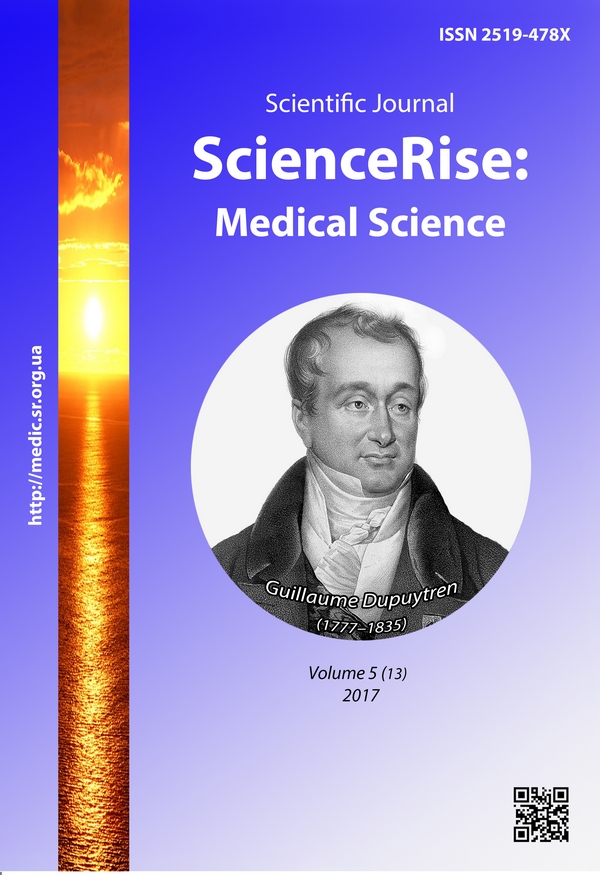Hyperalgesia syndrome in animals and methods of its treatment according to experimental data and morphometry
DOI:
https://doi.org/10.15587/2519-4798.2017.103051Keywords:
hyperalgesia, analgesia, cortisol, hyperglycemia, caragenin, conducting anesthesia, bupivacaine, fentanyl, ketamineAbstract
Aim. The assessment and choice of analgesia method relative to hyperalgesia development in the experiment.
Methods. Antiflogogenic effect of preparations was studied on the model of caragenin edema in 147 white non-linear rats with the mass 120–150 g. As a hyperalgesia model was used a caragenin edema. It was reproduced by the subplantar administration of 0,05 ml of 1 % caragenin solution in the right back extremity of the animal.
Results. The combined use of bupivacaine regional analgesia manifested the moderate antiflogogenic effect (AFA was 25,3, 20,9 and 11,6 %, respectively), whereas fentanyl administration is, on the contrary, associated with the growth of prostaglandin edema. The conducting anesthesia with bupivacaine led to the more expressed analgesic effect that was proved by the level of corticosterone in blood. In 5th group (bupivacaine) the corticosterone level was 102,8±8,1 ng/ml that is 2,5 times less than in 2 one (fetanyl) and in 3 group (ketamine) (р<0,05)
Conclusion. The complex study of reactions of pain behavior, physiological rates and laboratory stress tests demonstrated that the use of bupivacaine conducting anesthesia led to the more expressed analgesic effect
References
- Ayzenberg, V. L., Ulryh, G. Е., Czupyn, L. E., Zabolotskyi, D. V. (2012). Regyonalnaya anestezyya v pedyatryi. Saint Petersburg: Syntez Buk, 304.
- Kuchyn, Y. L., Glumcher, F. S., Byelka, K. Y. (2012). Opioyid-indukovana giperalgeziya pid chas analgosedaciyi u paciyentiv z cherepno-mozkovoyu tramvoyu. Bil, znebolyuvannya ta intensyvna terapiya, 1, 254–257.
- Kuchyn, Y. L. (2013). Stres-indukovana giperalgeziya u paciyentiv z mnozhynnoyu travmoyu. Bil, znebolyuvannya ta intensyvna terapiya, 2, 262–266.
- Angst, M. S., Clark, J. D. (2006). Opioid-induced Hyperalgesia. Anesthesiology, 104 (3), 570–587. doi: 10.1097/00000542-200603000-00025
- Celerier, Е., Gonzalez, J. R., Maldonado, R. et. al. (2006). Opioid-induced hyperalgesia in a murine model of postoperative pain: role of nitric oxide generated from the inducible nitric oxide synthase. Anesthesiology, 104 (3), 546–555. doi: 10.1097/00000542-200603000-00023
- Wilder-Smith, O. H., Arendt-Nielsen, L. (2006). Postoperative hyperalgesia: its clinical importance and relevance. Anesthesiology, 104 (3), 601–607. doi: 10.1097/00000542-200603000-00028
- Lavand'homme, P., De Kock, М., Waterloos, Н. (2005). Intraoperative epidural analgesia combined with ketamine provides effective preventive analgesia in patients undergoing major digestive surgery. Anesthesiology, 103 (4), 813–820. doi: 10.1097/00000542-200510000-00020
- Koppert, W., Schmelz, M. (2007). The impact of opioid-induced hyperalgesia for postoperative pain. Best Practice & Research Clinical Anaesthesiology, 21 (1), 65–83. doi: 10.1016/j.bpa.2006.12.004
- Lee, М., Silverman, S., Hansen, Н., Patel, V. B., Manchikanti, L. (2011). A comprehensive review of opioid-induced hyperalgesia. Pain Physician, 14 (2), 145–161.
- Unal, M., Gursoy, S., Altun, A., Duger, C., Kol, I. O., Kaygusuz, K. et. al. (2013). Ineffective Doses of Dexmedetomidine Potentiates the Antinociception Induced by Morphine and Fentanyl in Acute Pain Model. The Korean Journal of Physiology & Pharmacology, 17 (5), 417–422. doi: 10.4196/kjpp.2013.17.5.417
- Ві, Y., Wang, В., Yin, Z., Zhang, G., Chen, H., Wang, M. (2014). Effects of stellate ganglion block on AMP-ativated protein kinase and astrocyte in hippocampal neurons in postoperative aged rats. Zhonghua Yi Xue Za Zhi, 94 (28), 2222–2226.
- Erdivanli, В., Altun, M., Sezen, O. K., Colakoglu, S. A. (2013). Anti-Nociceptive, Analgesic and Pathohistological Effects of Intrathecal Dexmedetomidine and Bupivacaine in Rats. Brazilian Journal of Anesthesiology, 63 (2), 183–187. doi: 10.1016/s0034-7094(13)70212-5
- Blecharz-Klin, K., Joniec-Maciejak, I., Piechal, A., Pyrzanowska, J., Wawer, A., Widy-Tyszkiewicz, E. (2014). Paracetamol impairs the profile of amino acids in the rat brain. Environmental Toxicology and Pharmacology, 37 (1), 95–102. doi: 10.1016/j.etap.2013.11.004
Downloads
Published
How to Cite
Issue
Section
License
Copyright (c) 2017 Dmytro Dmytriiev

This work is licensed under a Creative Commons Attribution 4.0 International License.
Our journal abides by the Creative Commons CC BY copyright rights and permissions for open access journals.
Authors, who are published in this journal, agree to the following conditions:
1. The authors reserve the right to authorship of the work and pass the first publication right of this work to the journal under the terms of a Creative Commons CC BY, which allows others to freely distribute the published research with the obligatory reference to the authors of the original work and the first publication of the work in this journal.
2. The authors have the right to conclude separate supplement agreements that relate to non-exclusive work distribution in the form in which it has been published by the journal (for example, to upload the work to the online storage of the journal or publish it as part of a monograph), provided that the reference to the first publication of the work in this journal is included.









